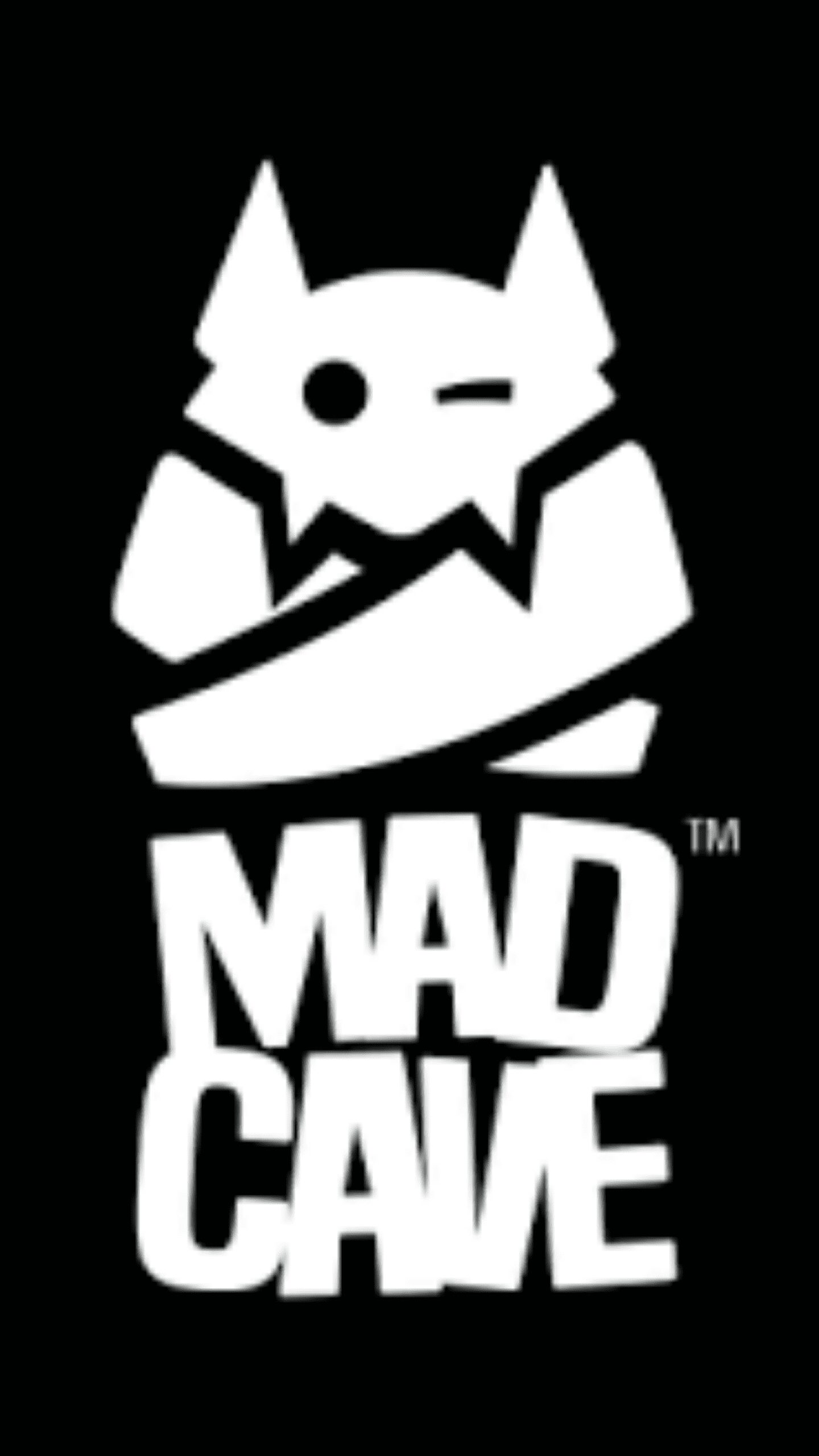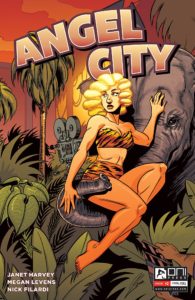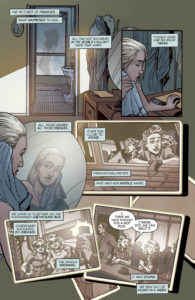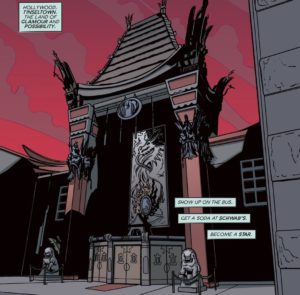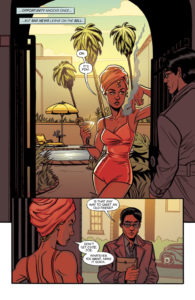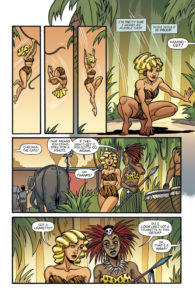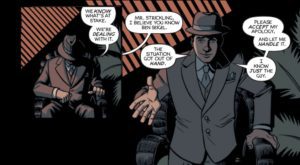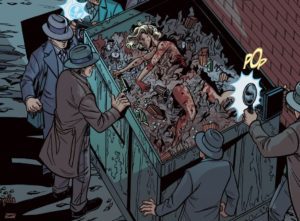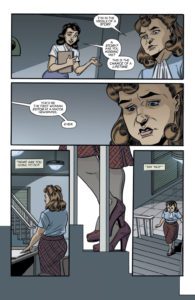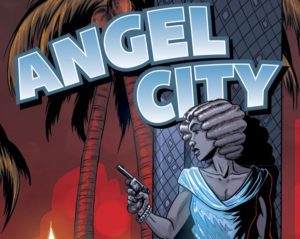I had the opportunity to speak to the creative team behind the comic book thriller Angel City from Oni Press. I was able to interview both the writer of the series Janet Harvey as well as the artist Megan Levens. We discussed the significance of setting the story in 1940’s Hollywood, strong female characters, the history of Hollywood and the unique look and feel of noir cinema.
Deron Generally (GWW): What are some of the things you found unique in this collaboration that you haven’t experienced before?
Janet Harvey: Well, this is the first time I’ve ever had the opportunity to collaborate with an artist on anything longer than one issue, so it was all new! And working with Megan was just such a complete joy on all counts. By the time we were on issue three or four, I felt like I knew the characters through Megan’s drawings; I could picture how they would react to each other. So I was writing for the characters she was drawing, if that makes sense. And, she brought so much to the storytelling. I think someone in a review called out the panel where Aggie is ascending the stairs to the publisher’s office, and the focus on her legs—in a skirt and high heels— really calls attention to her outsider status as a woman, which adds even more tension to her conflict. Megan really takes the storytelling to another level.
Megan Levens: I’ve worked with other female writers, but I think for us to be a female creative duo in the typically male noir genre, that was a lot of fun. Janet had such great faith in me being able to stretch my artistic muscles to draw gangsters and guns and the occasional gruesome murder.
GWW: Hollywood in the 40’s is such an interesting place to set a story. What made you decide on the time period and location to tell this particular story?
Janet Harvey: Well, it’s interesting because the 40s and 50s are generally considered the “noir” time period, but I actually set Angel City in 1939. That year is generally considered the apex of the Hollywood “Golden Age.” The Wizard of Oz and Gone With the Wind were both nominated for Oscars that year. MGM ruled the town, color movies were just starting to be made. There were rumblings about what Hitler was doing in Europe, but, for Americans, World War II wasn’t even a remote possibility yet. And you have the 1930’s Art Deco architecture, the gowns, and cars of the period. I also felt like it gave us room to grow in the future. We know what happens next in history, but the characters don’t. When the Japanese bomb Pearl Harbor, what happens to Joe? Will historical events change his relationship with Dolores?
GWW: Were there any other things like music or movies that inspired the visual look of the series?
Megan Levens: I had my swing jazz playlist on heavy rotation while working on this book, for sure. Noir isn’t something I was super familiar with, at least not in the way that Janet was, so I went back and looked up scenes from old movies to get ideas for camera angles or scene compositions I might not have thought of.
GWW: I’ve always been a fan of this time in the history of the entertainment industry. It was almost one of the last holdouts of the wild west and everyone seemed to flock to California for its untapped potential.
Janet Harvey: It is! I love that in its early days, Hollywood was becoming this very cosmopolitan town, but it still had roots as a lawless Western outpost. The city government was basically still very corrupt at this point in time. And the LAPD—it took them almost 50 years to solve a single gang-related case. They were legendary. It was also an island of glamour in the midst of the Depression. When all other industries were failing, the movie industry flourished. People would take what little money they had and go see Busby Berkeley musicals, to escape their everyday struggles.
GWW: I love the artwork in this series, especially the contrast between some of the softer, curved angles and the sharp ones. Was there a specific visual style you were going for?
Megan Levens: I try to always bring my own personal style to every project I work on, no matter the story or the subject matter. For me the focus is always on the characters and their emotions, and especially for a character like Dolores, being able to show her depth beyond just being a badass was important to sell why she’s motivated to do what she does in this story.
GWW: Dolores Dare is a dynamic, strong-willed, and capable character. Was there anyone in your personal life or in the past that inspired her?
Janet Harvey: In my own life, I feel like I’ve been lucky to know many women who are dynamic, strong-willed, and capable—and I’m related to a few of them! I feel like it’s doing them justice to present someone in a story who is a full-rounded person who rises to the occasion when trouble hits because those are the people who I admire. But if there’s one person in my life who has been a real touchstone in creating Dolores’ character, it would be my grandmother, Rita Hallmeyer. She grew up in the Depression, so she had a no-nonsense outlook on life and she took no guff from anyone. She used to say things like, “If you’re depressed, shave your legs, it’ll make you feel better.” That was basically her attitude about life —the John Wayne school of advice: tough it out and don’t cry about it. Now, admittedly, shaving your legs is not the most enlightened way to work through your emotional turmoil. But honestly? It kind of helps!
GWW: All of these characters are so distinct in their design. I would think that it would be difficult to pick a favorite. With that in mind, Which character or scenario did you have the most fun drawing?
Megan Levens: I have a tendency to develop crushes on my leading men in the comics I draw, so I really liked drawing Joe. That little strand of hair that always falls loose over his face… I also loved Rita. And Dolores was especially fun because I had free reign to draw an athletic, muscular woman. Janet and Ari Yarwood (our editor) knew that she needed to look convincingly fit to play this acrobatic mob enforcer, so her physique was great fun to draw.
GWW: There are many elements to Faye’s death that are reminiscent of the Black Dahlia murder during the same period. Are they linked in the story?
Janet Harvey: I did a lot of research into the Black Dahlia murder when I was writing the book. One of the most interesting theories about the killer that was especially inspirational to the story of Angel City was from a book called The Black Dahlia Files: The Mob, the Mogul, and the Murder That Transfixed Los Angeles by Don Wolfe. The author had an “uncle” (actually, his mother’s boyfriend) who was marginally involved with the mob, particularly with Bugsy Siegel, and he makes an interesting case for the Black Dahlia murder being mob-related. For instance, the vacant lot where they found Elizabeth Short’s body was practically in gangster Jack Dragna’s back yard, and Dragna and Bugsy were in a battle over turf at the time. So the theory was that the murdered girl might have been some kind of message to Dragna. I borrowed a bit from that story, mainly the turf struggles between the LA and East Coast mob. But the story of why Frances was killed in Angel City is very different.
GWW: Was there anything that you found a challenge to bring out in the art? How did you overcome that challenge?
Megan Levens: Capturing the character of LA was something I definitely paid a great deal of attention to. Living there and working on the book, some of the locations I was drawing still existed, and others had changed or been torn down over time. I wanted to be sure that anyone who’d ever been to or lived in LA would recognize it immediately, but that the details were historically accurate to the best of my ability to research.
GWW: Was there anything in the history of this period that you found particularly interesting?
Janet Harvey: The other thing that people don’t really talk about much anymore is that, at this time, the culture of Hollywood was very much a culture of working class party people who had suddenly gotten money, and were making their own fortunes on the sunny west coast. It didn’t matter if you had spent your whole life as a plumber or a waitress; in Hollywood, if you had good looks and/or street smarts, you could make a way for yourself. If you read the trade papers of the era, you actually see letters to the editor complaining about how these “low” people from the slums are ruining the morals of middle America, with their wild parties and their racy movies. That’s why the Hayes Code was started. We have this very sanitized, whitewashed idea of what the past looks like but if you look at Pre-Code movies, you see it’s a lot racier—and more diverse!—than history books would lead you to believe.
GWW: I appreciate how you weave in local historic moments into the narrative seamlessly. Why add the historical articles at the end of each issue?
Janet Harvey: Mainly because there’s so much good material that I came across in my research, and I couldn’t include it all in the story! Sometimes you’ll come across a story that just needs to be told! Girl 27, the Zoot Suit Riots, the Bugsy Siegel and Aggie Underwood stories—there’s just a lot of good true stories there. And I felt like it added to the “True Detective” vibe of the book.
GWW: Many of the scenes move from panel to panel like the scenes of a classic noir film of the period and some of the quieter moments even relay some of that tension, like Aggie being called to the Publisher’s office. Was that deliberate in how you wanted to convey those moments?
Megan Levens: Oh, absolutely. Again it was going back to the films of the period and taking cues from how they approached the storytelling and acting
GWW: Where do you see Dolores at the end of the series?
Janet Harvey: When one door closes for Dolores, another one opens! She’ll end up in a better place, with people who support her for who she is, not just for being a good-looking, tough gun moll.
GWW: Now that this particular story has come to a close, is there a similar story that the two of you would like to tell?
Megan Levens: I know we’ve talked about doing spin-offs of the various characters, and that we both love Rita so much that she’s probably on the top of our list. Really I’d jump at the chance to work with Janet again, we really got into a groove working together as we got into the middle of the story so her writing and my art were very much in sync by the time we wrapped this story up.
Janet Harvey: We’ve been talking about a couple of projects, and I think we’d both love to do more ANGEL CITY. A Rita spin-off would be amazing!
GWW: If you could work on any book together featuring an established character, which book would it be and why?
Megan Levens: Ooh, well my vote would be for Black Widow, because I know Janet can write great action and intrigue, and I just want to draw Black Widow.
Janet Harvey: Oh man! I’d love to write Natasha, that would be rad. I’d also really love to see what Megan would do with Gamora. I feel like we could really rock a Gamora story.
Megan Levens: Oh yes please. Marvel, are you listening?
Angel City completed its final issue in March and I highly recommend picking it up wherever you get your comics. It is a great series with an engaging film noir story. The artwork is beautiful to look at and the series will be well worth your time.
Deron Generally
@grimorian219

